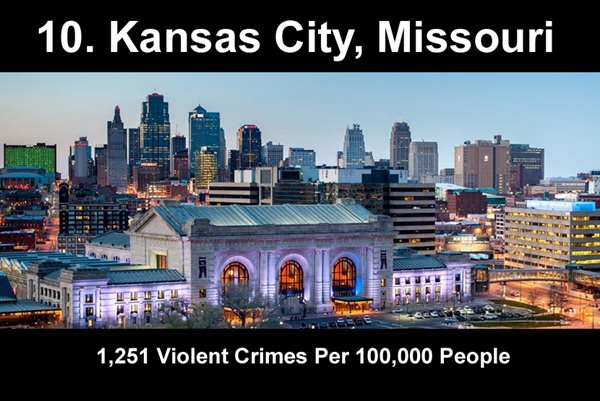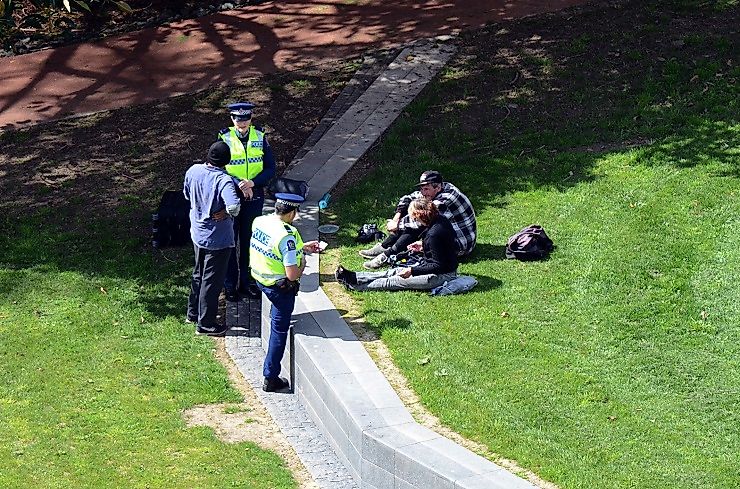To identify the 25 most dangerous U.S. cities, 24/7 Wall St. reviewed violent crime rates in cities with at least 100,000 people from the FBI's 2015 Uniform Crime Report released Monday. We also considered these data for each year from 2011 through 2015. Annual unemployment rates for 2015 came from the Bureau of Labor Statistics . Median household income, poverty rates, the percentage of adults with at least a bachelor's degree, population, and the percentage of adults with at least a high school diploma came from the U.S. North Carolina is one of a minority of states to report an increase in violent crime between 2017 and 2018. There were 39,210 reported incidents of rape, robbery, homicide, and aggravated assault in the state in 2018, a 3.1% increase from the previous year.
Meanwhile, the number of violent crimes reported nationwide fell by 3% over the same period. Still, North Carolina's violent crime rate of 377.6 incidents per 100,000 people is closely in line with the comparable national rate of 380.6 per 100,000. There were 22,624 violent crimes reported in Colorado in 2018, a near nation-leading 8.2% increase from the previous year.
Though the number of murders and robberies in the state fell between 2017 and 2018, cases of aggravated assault, the most common type of violent crime, increased by 13.7%, driving the overall uptick. Meanwhile, the number of violent crimes committed nationwide fell by 3% over that period. Still, Colorado's violent crime rate of 397.2 incidents per 100,000 people is only slightly higher than the comparable national rate of 380.6 per 100,000.
To assess the safest cities, MoneyGeek analyzed crime data, including violent crimes such as murder, rape and aggravated assault and property crimes such as home burglary and motor vehicle theft. MoneyGeek calculated each city's cost of crime and ranked the cities based on the cost of crime per capita. Additionally, researchers have quantified how much more violent crimes cost a community than property crimes. All these dynamics have been covered in our ranking methodology.
We have already elaborated the crime scenario for 2020 in our previous article Top 15 U.S. Cities With Highest Number of Murders in 2020, where we have discussed the number of murders per day per 100,000 people. Since, some cities do not report crime data in real time, but only in a few months' gap, we have based our rankings of the 30 most dangerous cities in the US on the FBI Uniform Crime Report data for 2019. This gives us a more holistic result without excluding any of the major cities. In this article we ranked cities based on the rate of violent crimes per 100,000 inhabitants.
Only cities that have a population of 250,000 or more is included in this article. Violent crimes would include murder, rape, robbery and aggravated assaults. Wisconsin has a violent crime rate of 295.4 incidents for every 100,000 people, lower than in most states and well below the 380.6 per 100,000 national rate. Many of the violent crimes committed in Wisconsin in 2018 were concentrated in Milwaukee, the largest city in the state.
Of the 17,176 reported robberies, rapes, murders, and aggravated assaults in Wisconsin in 2018, nearly half were committed in Milwaukee. While there are some states where no city has a higher violent crime rate than the U.S. as a whole, most do. Some of the cities on this list are located in metro areas where violent crime rates have spiked in recent years. In cities with high rates of violence, other non-violent crimes like burglary and motor vehicle theft also tend to be common.
The cities on this list are often also the same cities with the highest property crime rate in the state. South Dakota's violent crime rate of 404.7 incidents per 100,000 people is slightly higher than the national rate of 380.6 per 100,000. While the state has higher than average rates of rape and aggravated assault, it also has the lowest murder rate in the United States. There were just 1.4 homicides committed in South Dakota for every 100,000 people in 2018, a fraction of the national rate of 5 per 100,000 people. Iowa ranks among the safest states in the Midwest and as the 15th safest state nationwide.
Iowa's 2018 violent crime rate of 250.1 per 100,000 people is well below the 380.6 per 100,000 national rate. Areas with low rates of violence also tend to have low property crime rates, and Iowa is no exception. There were 1,691.5 property crimes in Iowa for every 100,000 people in 2018, far less than the national rate of 2,199.5 per 100,000. There were 227.1 violent crimes reported for every 100,000 people in Idaho, well below the national violent crime rate of 380.6 per 100,000. Idaho's robbery rate of 11.4 incidents per 100,000 people is the second lowest of any state, trailing only Vermont. Idaho's property crime rate of 1,461.4 per 100,000 is also well below the national rate of 2,199.5 per 100,000.
Despite a 1% population increase between 2017 and 2018, the number of violent crimes committed in Georgia fell by 7.4% over the same period, more than double the 3% national decline. As it stands, Georgia's violent crime rate of 326.6 incidents per 100,000 people is well below the 380.6 per 100,000 national rate. The rate of rape in Georgia, at 25.2 reported incidents per 100,000 people is the fourth lowest of any state.
The most dangerous city in the United States is Detroit, Michigan. Detroit has a violent crime rate of 2,007.8 incidents per 100,000 people with a total of 261 homicides in 2018. Detroit is the only midsize or large city in the United States with a violent crime rate of over 2,000. With a population of less than 700,000 people today, Detroit reported about 13,500 violent crimes in 2018 – a rate higher than cities with double the population.
Detroit's scarce economic opportunities have led to an annual unemployment rate of 9.0% and 37.9% of residents living below the poverty line. There were 18,380 violent crimes committed in Oklahoma in 2018, a 2.2% increase from the previous year. The state's violent crime rate of 466.1 incidents per 100,000 people make it one of the most dangerous states in the Midwest and the twelfth most dangerous nationwide. Property crimes – a category that includes offenses like motor vehicle theft and burglary – are also relatively common in Oklahoma. There were 2,875 property crimes for every 100,000 people in the state, eighth most among states.
With a population of 30,898 people, the area sees uncommonly high crime rates for an area with a small population. The violent crime rate is 361 percent higher than the national average, and the property crime rate is 112 percent higher than the national average. Residents have a one in 17 chance of experiencing crime in Danville.
Stockton had 889 incidents of violent crime for every 100,000 residents in 2012, higher than all but a handful of metro areas nationwide. That year, there were 89 murders, or 12.7 per 100,000 residents, among the highest rates in the nation. Cases of aggravated assault and robbery were also extremely frequent. Violent crime was such a problem in Stockton that year that the city's police declared a policy of immediately dispatching officers only in cases of violent crimes and crimes in progress. The city of Stockton, which is currently working on plans to exit from bankruptcy, has lost police officers in recent years due to a combination of layoffs and retirements.
At the end of 2013, 12% of the area's workforce was unemployed. While this was down from 16% two years before, it was still among the worst unemployment rates in the nation. Memphis's violent crime rate of 1,740 incidents per 100,000 residents trails only three other U.S. cities. Nationwide, aggravated assault is the most common of all violent crimes. In Memphis, there were 7,653 reported aggravated assaults in 2015, or 1,163 per 100,000 people, the highest such rate of any other city. Detroit, Michigan, has the second-highest violent crime rate in the United States with 2,056.7 violent crimes per 100,000 people.
Some of the most common crimes in the city are aggravated assault, assault with a deadly weapon, rape, armed robbery, murder and non-negligent manslaughter. It is important to note that crime in Detroit, in general, has been decreasing over recent years. The number of murders and homicides in the city have been lower than previous years, with 267 homicides in 2018. There were 382.3 violent crimes for every 100,000 people in Indiana in 2018, closely in line with the comparable national rate of 380.6 per 100,000. As is often the case, crime in the state tends to be concentrated in cities.
Of the 25,581 violent crimes reported across Indiana in 2018, about 44% were committed in Indianapolis, the largest and most dangerous city in the state. Indianapolis's violent crime rate of 1,272.8 incidents per 100,000 people is more than triple the comparable national rate. Including 188 homicides, there were 5,762 violent crimes in St. Louis in 2015. Adjusting for population, the city's murder and violent crime rates, at 59 murders and 1,817 per 100,000 city residents, are each the highest in the country. The number of violent crimes reported in St. Louis increased by 7.7% last year, faster than the national uptick of 3.9%.
Over the last five years, however, the incidence of violent crime is down by 3.2%. The number of violent crimes committed in Nevada in 2018 fell by 1.5% from 2017 to 2018. The state also reported near nation-leading declines in murder and robbery, 24.1% and 20.2%, respectively. Montana's violent crime rate of 374.1 incidents per 100,000 people is closely in line with the nationwide rate of 380.6 per 100,000.
As is the case nationwide, aggravated assault is by far the most commonly reported violent crime in the state. Robbery, however, is far less common in Montana than it is in most other parts of the country. There were 25.3 reported robberies for every 100,000 people in Montana in 2018, less than one third the national rate of 86.2 per 100,000. Overall, violent crime is less common in Nebraska than it is nationwide. There were 284.8 violent crimes for every 100,000 people in the state in 2018, below the 380.6 per 100,000 national violent crime rate. However, rape, one of the four components of the violent crime rate, is more common in Nebraska than it is in much of the rest of the country.
There were 63.9 reported incidents of rape for every 100,000 Nebraskans in 2018, the eighth highest rate among states and well aboe the national rate of 42.6 incidents per 100,000 people. Only cities with populations of 100,000 people or more were evaluated. The poverty rate and unemployment rate were also evaluated for each city, as these economic factors often correlate with crime rates.
The 50 most dangerous cities in the United States were determined from this data. While Yakima residents often felt unsafe walking home alone at night, the area's violent crime rate was actually lower than the national rate. Like most metro areas in which residents do not feel safe walking alone at night, Yakima is struggling economically. Nearly one-quarter of the area's residents had to rely on food stamps for at least part of 2012, and 23.1% of residents lived in poverty in 2012 — both among the worst rates in the country.
SafeWise used violent crime and property crime as defined by the FBI, since they were using the FBI's numbers. "Violent crimes" include aggravated assault, murder, rape, and robbery; "property crimes" include burglary, larceny-theft, and motor vehicle theft. There were 474.9 violent crimes for every 100,000 people in Arizona in 2018 – more than the 380.6 per 100,000 national rate.
The state's higher-than-average violent crime rate still represents a marked improvement from 2017, when there were 505.7 incidents per 100,000 people. The state reported a 4.5% reduction in the number of violent crimes committed between 2017 and 2018 – greater than the 3% national improvement. Still, after adjusting for population Chicago does not rank as the most dangerous city in the state – that distinction goes to Danville. There were 1,791.5 reported incidents of rape, robbery, homicide, and aggravated assault for every 100,000 people in Danville in 2018, well above Chicago's violent crime rate of 1,006.1 per 100,000. Florida's violent crime rate of 384.9 incidents per 100,000 is almost exactly in line with the corresponding national rate.
While the state as a whole is not especially dangerous, parts of it are. In Florida City, for example, the violent crime rate is a staggering 3,052.8 incidents per 100,000 people, eight times the national violent crime rate. Other cities in Florida, like Opa Locka and Lake City, also rank among the most dangerous in the country, with violent crime rates of 2,346.5 and 1,214.9 per 100,000, respectively. Unlike most states, Oregon reported an uptick in violent crime over the last year.
There were 11,966 incidents of robery, rape, murder, and aggravated assault in the state in 2018, a 2.9% increase from the previous year. Still, Oregon's violent crime rate of 285.5 incidents per 100,000 is below that of most states and well below the national rate of 380.6 per 100,000. Like several other nearby states in the New England region, Connecticut ranks among the safest places in the country. There were 207.4 violent crimes reported for every 100,000 state residents in 2018, the fifth least among states.
As is often the case in areas with low violent crime, other types of crime are also relatively uncommon in Connecticut. There were 1,684 property crimes, such as motor vehicle theft and burglary, in the state for every 100,000 people in 2018 – well below the national rate of 2,199.5 per 100,000. McAllen was the only metro area in which less than half of all respondents felt safe walking home alone at night. However, violence along the border with Mexico remains a concern for many McAllen residents.
The State Department warns against traveling to the neighboring city of Reynosa, Mexico, due to high levels of drug-related violence. Additionally, nearly 25% of residents stated they did not have enough money for adequate shelter at some point in the previous year, by far the most of any metro area. A lack of adequate shelter may be tied to the relatively low economic prosperity in the region. In 2012, 34.5% of residents lived below the poverty line, and the median household income was just $33,761, both among the worst in the nation. While Lubbock ranked high in violent crime and property crime rates, study authors note is has the fewest murders of any of the top 10 most dangerous cities. They report property crimes victimized one in 25 people in Lubbock last year.
Our research reveals the 100 most dangerous cities in America with 25,000 or more people, based on the number of violent crimes per 1,000 residents. Violent crimes include murder, rape, armed robbery, and aggravated assault. The data used for this research are the number of violent crimes reported to have occurred in each city, and the population of each city. Missouri is one of only eight states nationwide with a violent crime rate of more than 500 incidents per 100,000.
In St. Louis, for example, there were 1,800.4 violent crimes for every 100,000 people in 2018, nearly five times the national violent crime rate of 380.6 per 100,000. There were 28,320 violent crimes reported in Maryland in 2018, a 6.6% decline from the previous year – more than double the 3% national decline in violence over the same period. Despite the improvement, Maryland's violent crime rate of 468.7 incidents per 100,000 people is considerably higher than the 380.6 per 100,000 national rate. Michigan has a 2018 violent crime rate of 449.4 incidents for every 100,000 people, effectively unchanged from the previous year. About 30% of the 44,918 violent crimes committed in Michigan in 2018 were in Detroit.
With a violent crime rate of 2,007.8 incidents per 100,000 people, Detroit is one of the most dangerous cities in the country. However, it falls short of ranking as the most dangerous city in the state. There were 4,097 violent crimes in Delaware in 2018, or 423.6 for every 100,000 people, a higher violent crime rate than in most states.



























No comments:
Post a Comment
Note: Only a member of this blog may post a comment.